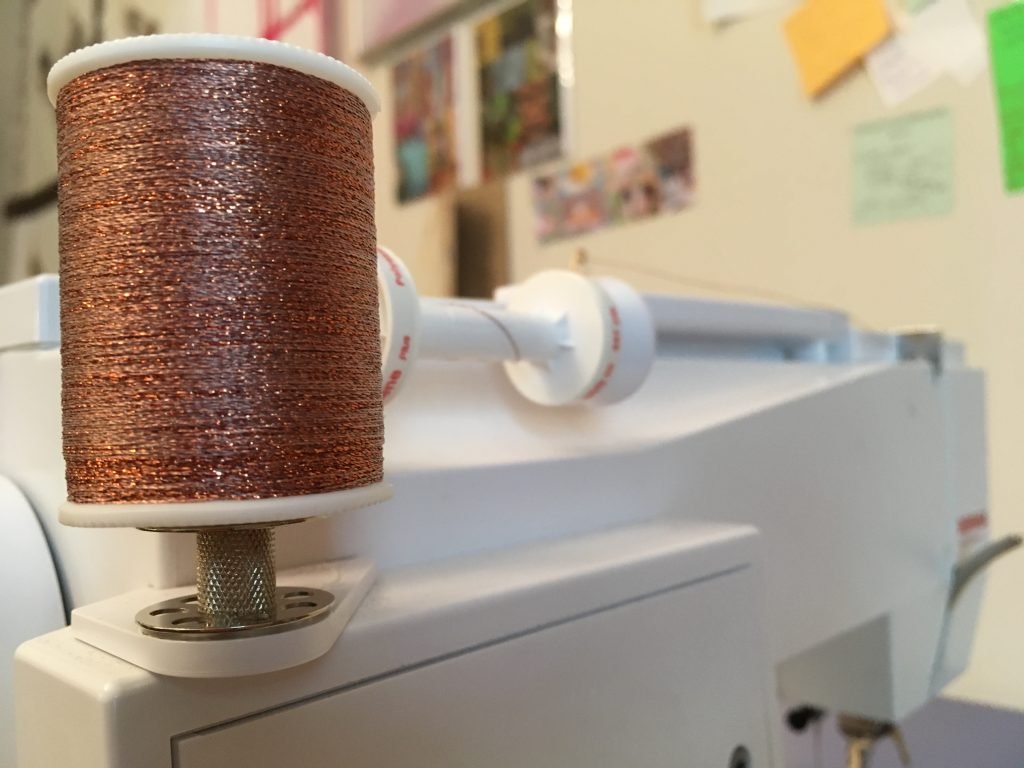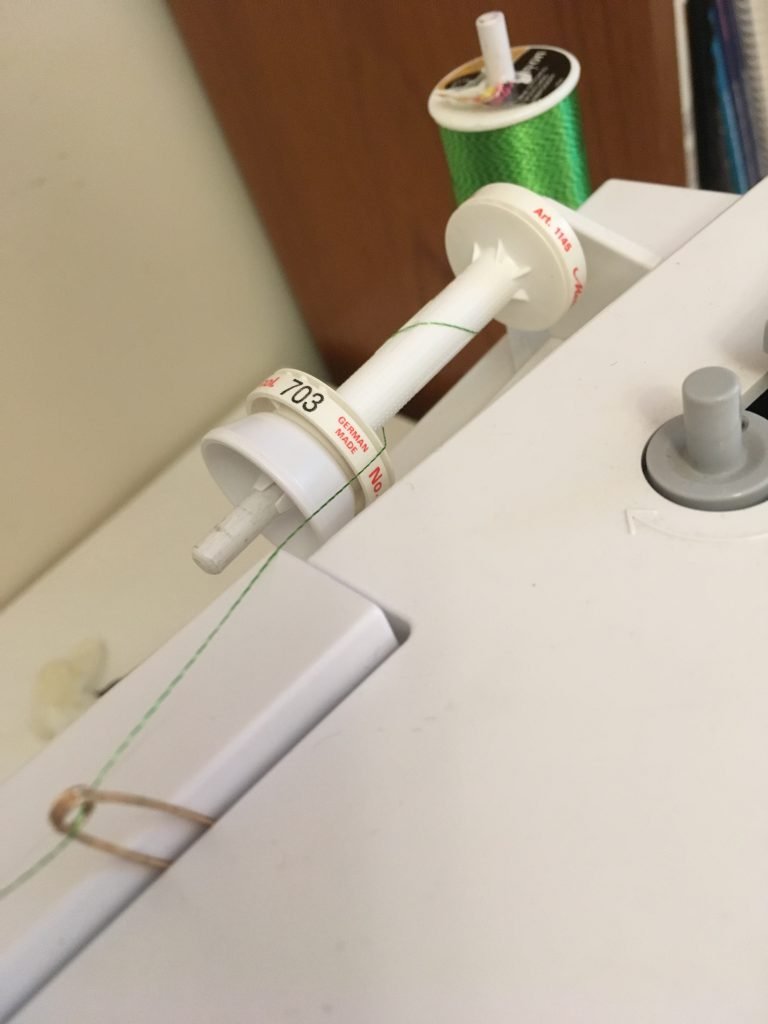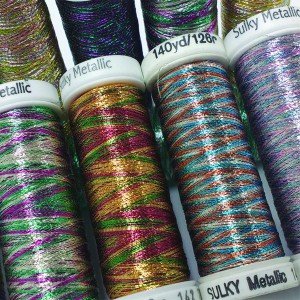As promised, what follows is part two in this set of blog posts featuring info I found on machine stitching with specialty threads as applied during the creation of “Bright Delight”.
Now that we’re armed with the knowledge of the characteristics of specialty threads and have rule #1* firmly in mind, we’re ready to get on with the business of sewing with metallics.
Regardless of how the specialty thread is wound on the spool (cross wound or stacked), both types feed best from the vertical spindle**.
Modifying the thread path from spindle to the first thread guide of the sewing machine is a key factor in controlling the natural curl of specialty threads.
Instead of purchasing a specialty thread stand attachment for my Bernina***, this is what I came up with after much consideration, research and trial & error. It works beautifully and didn’t cost me a cent.

place spool of thread on top of empty bobbin on vertical spindle to prevent thread tangling on bottom then… 
twist thread around empty thread spool on horizontal spindle & thread through safety pin before entering machine thread guide
With the specialty thread now safely and gently guided through the machine, here are a few more tips, tools and settings to further facilitate successful stitching:
- Reduce upper thread tension (lower number) and increase stitch length – sew on sample fabric and adjust as needed. (suggested settings – #2 tension and #3 stitch length)
- Suggested foot – wide toed embroidery foot as it will accommodate both straight and decorative stitches. (#20 Bernina foot)
- Use only a Metallic or Topstitch needle as both have larger eyes and accommodate the special needs of these threads. (I prefer a Schmetz 90/14 Metallic needle as it has a polished eye which prevents snags specific to metallic thread)
- Use a fine, light weight ‘bobbin’ thread or plain, smooth polyester thread (not cotton!), or even a metallic thread in the bobbin. (I used the ‘bad’ skinny spool metallic thread as mentioned in part 1 in the bobbin which added an extra sparkle to the back of the quilt)
- Practice settings on sample fabric, adjust as needed and Sew Slow! (I used the ‘half-speed’ setting for starters to get the hand of it)
Now, go forth and work with those metallic threads!
(for general reference: here and here)
*Rule #1 is to Sew Slow.
**Yes, this goes against the norm of pairing cross wound spools with the horizontal spindle and stacked spools with the vertical spindle.
*** While there are a variety of specialty thread stand attachments available for most sewing machines, I opted to forgo the investment of one for the time being.

Wonderful guidance – I had a disaster working with metallic threads in the past. Perhaps I will pull them out of my thread stash someday….
Thanks for the kudos, Tierney. I have no doubt your creative curiosity will have you pulling out those pesky metallics for some future project!
Off topic … Cheers to your love for sewing and thanks for following Beach Walk Reflections. How did you discover it?
(this got caught in my spam file, so took awhile to reply, sorry)
Thanks for commenting! I found you via Merrill’s blog interview a few weeks ago.
That’s ok … At least you check your Spam folder.
You have shared a wealth of information. Maybe someday I will have to bite the bullet.
You know the old saying, “Where there’s a will there’s a way”. For myself, ‘Bright Delight’ screamed for some metallic thread and that forced me into figuring out how to manage that on my machine – hence I bit the bullet big time!
Now when something else screams for some metallic thread, I’ll be ready and able to fulfill the call!
Thanks for stopping by, Cindy.
I will be watching. The pleasure was mine. 🙂
Interesting info! I don’t have the option of a vertical spindle… but I probably won’t be working with metallic thread anyway. It’s beautiful but it sounds high maintenance. I’m glad you use it though… we get to see the lovely results!
It is high maintenance, but when used occasionally they pack a punch and are worth the extra effort IMHO!
Wow, this is precise and very helpful . You must have done a lot of research and trial and error. Good for you! the top photo is so pretty with all the colours, was a certain “hook” for me.
That ‘hook’ hooks most of us into trying these beauties in our quilts, too!
Thanks for the tips and what you gleaned – in case I should ever venture down this pathway…
You’re welcome!
Who knows, you’ve been exploring alot of creative pathways lately…
I have sewn with specialty threads many times, and your instruction/tips are spot on, Laura! I love your creativeness in threading the machine! Although I do have a thread stand, I have also used a safety pin, and a jar. Sewing slow is an absolute must with these threads!
I love your encouragement to go forth and play with these threads! The adjustments and effort are worth it! 🙂
Laura, thanks for the endorsement…sometimes ‘homemade’ solutions are easy to make fun of!!!! If I begin working with metallics on a more consistent basis I will definitely consider buying a specific thread stand attachment!
And yes, we all need to take time to just play –
🙂
I will be looking forward to seeing what you sew. And yes, sew slow!
Like I mentioned to Jill, going slow on projects is way underrated! As a teacher, I know you get it!
I definitely get it!
Thanks for the instructions, Laura. “Sew slow” has always applied to me. As I’ve mentioned before, I can hardly sew a button!
I learned during this metallic thread learning time that going ‘slow’ is a postitive attribute that applies to a lot of things and is way underrated as a method of progressing on any type of project!
Thanks for stopping by, Jill!
Congratulations on finding this ingenious method of sewing with metallic threads and for so generously sharing your tips and tricks. I am in awe of your patience, because I am sure it must have taken time and care to get it right.
You’re more than welcome, Mariss! My ‘patience’ is more like persistence and focus on the need to get it right! But I’ll take the more virtuous moniker of ‘patience’ if you insist!
😉
?
I don’t sew but I appreciate how much detail and effort it takes to create the beautiful items that you do. I like your metallic threads. They add some pizzazz to things.
Pizzazz – yes!
Hi Laura! Thank you for all the info and tips you’ve shared. I’m not quite ready to jump into sewing with metallic threads just yet . . . only because I’m not working on a project that could use it. Soon! ~smile~ Roseanne
You hit the nail on the head…I only delved into this because I was working on a project that **demanded** use of metallics! Hence the deep plunge (and stitch-ripping out times!) into understanding/learning a process towards successful stitching!
🙂
Great instruction! This makes me wish I knew how to use a sewing machine! But I have used yarn with metallic threads. They make a nice contrast to other types of yarn in a project. ?
All the bits and pieces of our (he)art are what makes it such an adventurous experience in sorting through and using them in various ways in our creations! I like your yarn/thread twists idea!
BTW: I’m finding my blogging posts to be more of a personal discipline in writing something comprehensive and understandable during these times of isolation/limited human interaction…keeping my mind sharp so to speak. Soooo, your feedback of this being instructive means I was successful in communicating an idea/procedure. YAY!